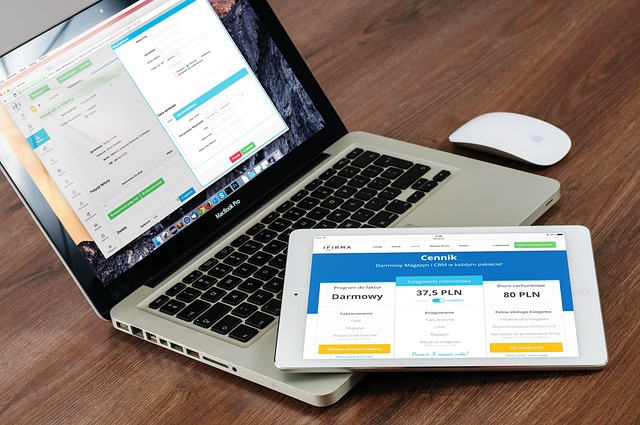Small businesses aiming for an effective and affordable website redesign should first assess their current platform, identifying strengths to preserve and weaknesses to address. Setting a realistic budget is essential, with research guiding allocation based on needs, audience, and goals. User-friendly platforms like WordPress, Wix, or Squarespace coupled with cost-effective design tools offer professional solutions within budget constraints. Simple design strategies focusing on layout, navigation, call-to-action buttons, images, and mobile responsiveness dramatically enhance user experience without significant costs. Content optimization through fresh text, strategic keywords, image compression, and simplified navigation further boost online presence. Tracking key performance indicators post-redesign ensures success and data-driven enhancements to serve target audience needs effectively.
Small businesses often strive to create an online presence with a website that reflects their brand and engages customers. However, redesigning can be costly. This article guides you through an affordable website redesign process tailored for small businesses. From understanding your needs and setting a realistic budget to choosing the right tools and implementing cost-effective design strategies, we provide actionable steps to enhance your online experience without breaking the bank. Discover how to optimize content and measure success, ensuring your website redesign yields tangible returns on investment.
Understanding Your Business Needs and Goals for a Website Redesign

Before diving into an affordable website redesign, small businesses must first grasp their unique needs and aspirations. A website is more than just a digital storefront; it’s a reflection of your brand identity and a tool to engage with customers. Understanding your target audience, their preferences, and how they interact online is crucial. This involves analyzing existing website data, gathering feedback from clients, and identifying areas where the current site falls short in terms of functionality or aesthetics.
For instance, a small clothing boutique might aim to enhance user experience through improved navigation and visual appeal to boost sales. A local restaurant could prioritize showcasing its menu and reservation system to attract more diners. Defining these goals is essential for guiding the redesign process, ensuring that the new website aligns perfectly with your business objectives and delivers an exceptional online experience.
Evaluating Your Current Website: Strengths and Areas for Improvement

Before considering a website redesign, it’s crucial to evaluate your current platform. Start by identifying its strengths—these could include user-friendly navigation, high-quality content, or effective conversion calls-to-action. Understanding these positive aspects will help guide the new design and ensure you’re not starting from scratch unnecessarily.
However, also be diligent in noting areas that need improvement. This might involve looking at site speed, mobile responsiveness, outdated visuals, or a lack of search functionality. Identifying these weaknesses is an essential step towards crafting a more affordable, effective Website Redesign tailored to your small business’s unique needs and target audience.
Setting a Realistic Budget for an Affordable Website Redesign

When considering a website redesign, setting a realistic budget is the first step to ensure an affordable and successful outcome. Small businesses should allocate funds based on their current digital presence, target audience, and desired goals. It’s essential to remember that every business has unique needs, so pricing can vary greatly for design packages. Researching market rates and comparing quotes from various web designers will help establish a benchmark for what is considered affordable within your industry and region.
Start by identifying must-have features and nice-to-haves to prioritize spending. Prioritizing core functionalities, such as an intuitive navigation menu, mobile responsiveness, and search engine optimization (SEO) best practices, should be the foundation of your budget. Additional features like advanced e-commerce capabilities or interactive elements might require a larger investment but can significantly enhance user engagement and conversion rates.
Choosing the Right Platform and Tools for Small Businesses

When considering a website redesign, small businesses should focus on choosing user-friendly platforms and tools that align with their budget and goals. Popular options like WordPress, Wix, or Squarespace offer cost-effective solutions with customizable templates, making it easy to create a professional online presence without breaking the bank. These platforms provide drag-and-drop functionality, ensuring even non-technical business owners can build and manage their own websites.
Additionally, leveraging affordable design tools such as Canva for graphics, Google Fonts for typography, and free stock image sites can significantly reduce costs associated with website redesign. These resources enable businesses to create visually appealing content without incurring high design fees. By strategically selecting the right platform and tools, small businesses can effectively rebrand and enhance their digital footprint while staying within budget constraints.
Simple Design Strategies to Enhance User Experience Without Breaking the Bank

Redesigning your website doesn’t have to be a costly endeavor for small businesses. Simple design strategies can significantly enhance user experience, driving better engagement and conversions. Start by simplifying your layout and navigation. Clean, intuitive designs help visitors find what they’re looking for faster. Use clear call-to-action buttons and consistent formatting throughout the site to create a seamless flow.
Another cost-effective approach is leveraging high-quality images and minimal graphics. Visual elements can break up content and slow down loading times, so use them strategically. Opt for crisp, professional photos over intricate illustrations unless they align with your brand identity. Additionally, ensure your website is mobile-responsive, as a growing majority of users access sites on their smartphones. Responsive design not only provides a better user experience but also improves search engine rankings.
Cost-Effective Content Optimization Tips for Your Website

Redesigning your website doesn’t have to break the bank. In fact, a strategic Website Redesign can be an affordable and powerful tool for small businesses looking to boost their online presence. One effective strategy is content optimization. Start by reviewing your existing pages and identifying areas for improvement. Update outdated text with fresh, engaging content that incorporates relevant keywords naturally. Keywords are crucial for search engine visibility, so ensure they’re strategically placed in titles, headings, and meta descriptions. Additionally, optimize images by compressing them for faster loading times without sacrificing quality.
Don’t overlook the power of user experience (UX) improvements either. Simplify navigation with a clean layout and intuitive design. Ensure your website is mobile-responsive, as many users access sites on their phones. These content and UX optimizations can significantly enhance your site’s performance, making it more appealing to customers while also improving search engine rankings—all without a hefty budget.
Measuring Success and ROI After Implementing Your Website Redesign

Measuring success after a website redesign is crucial for understanding the return on investment (ROI). Track key performance indicators (KPIs) such as conversion rates, bounce rates, and time spent on site to gauge how well your new design is performing. Compare these metrics against pre-redesign data to identify improvements or areas needing further optimization.
Additionally, analyze user feedback and behavior through analytics tools to gain insights into customer preferences and interactions. This qualitative data complements quantitative measures, providing a comprehensive view of your Website Redesign’s impact. By combining these approaches, you can make informed decisions on future enhancements and ensure your website continues to effectively serve your target audience.
